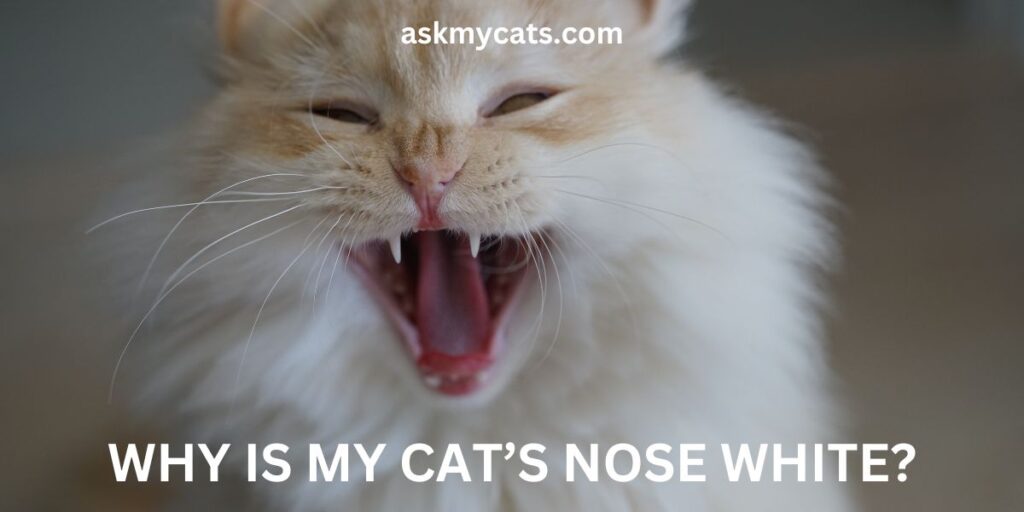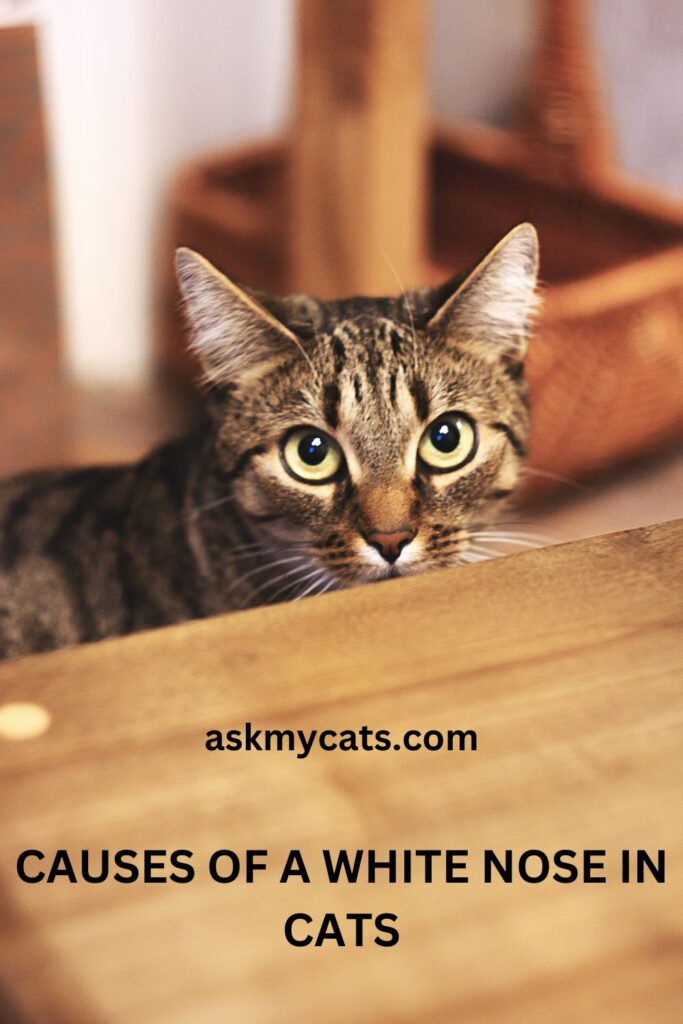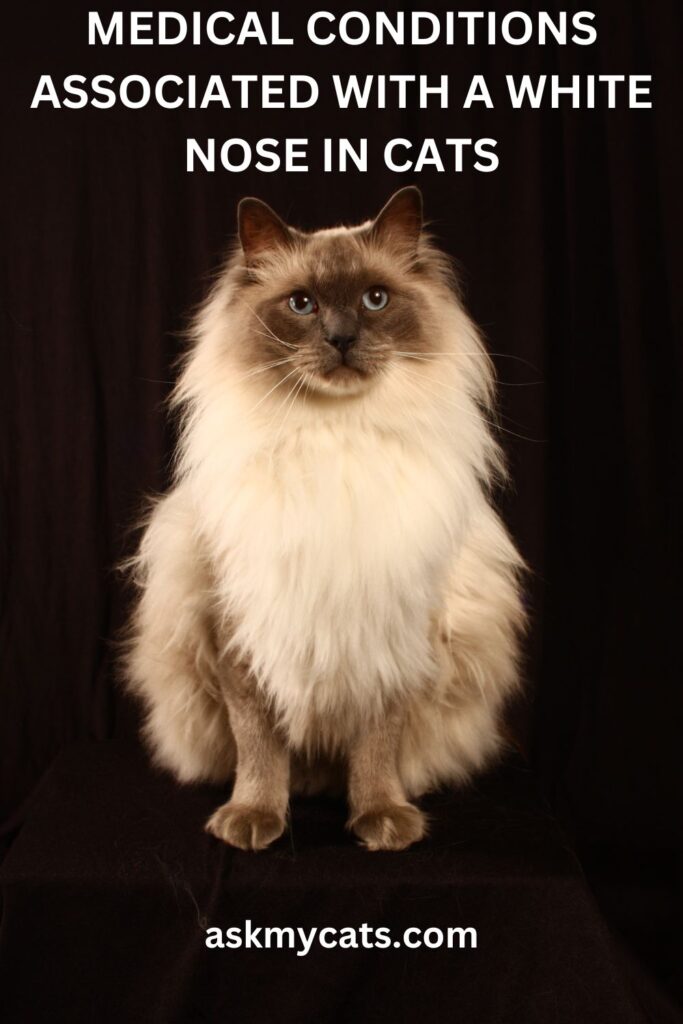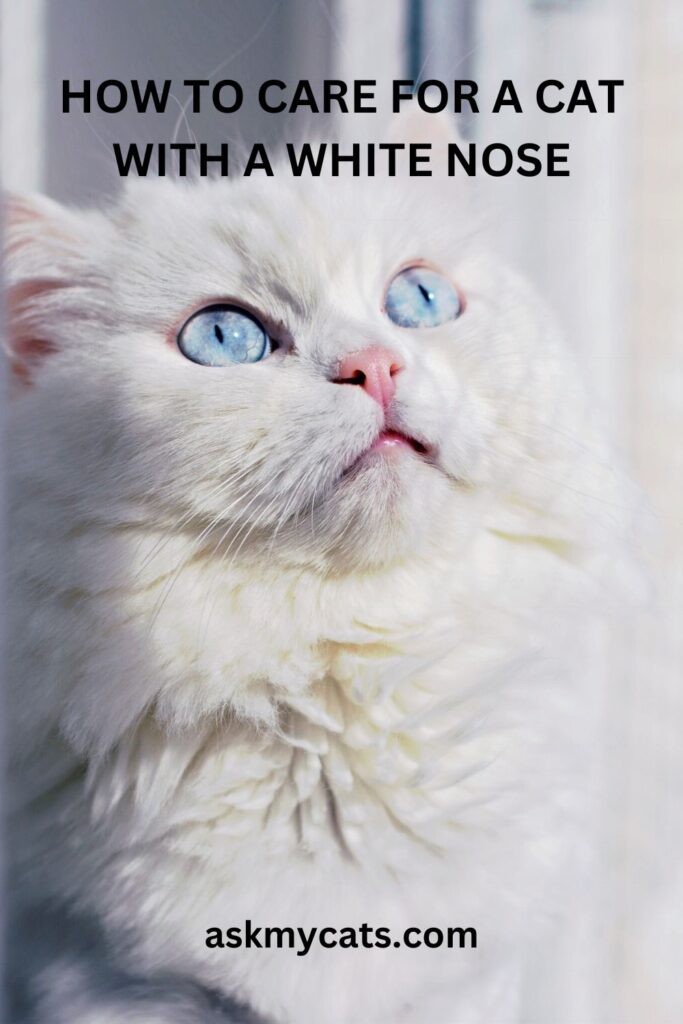Have you ever noticed that your feline friend’s nose is not just cute, but also quite fascinating?
While most cats have a pink or black nose, some have a distinctive white or pale color. But why is that? Is it a cause for concern, or just a quirk of nature?
In this article, we’ll explore the reasons behind your cat’s white nose, including the role of genetics, age, health, and even sun exposure.
Key Takeaways
- Cats can have a white nose due to various reasons including genetics, age, health conditions, and sun exposure.
- Some cat breeds, such as Siamese, Himalayan, or Birman, are more likely to have white noses due to their genetic makeup.
- Aging can cause a cat’s nose to lose pigmentation and turn white or pale.
- Health conditions such as vitiligo, allergies, infections, autoimmune diseases, and skin cancer can also affect the color and texture of a cat’s nose.
- Medical conditions associated with a white nose in cats include nasal planum depigmentation, vitiligo, feline leprosy, and skin cancer.
- Care for a cat with a white nose includes protecting it from the sun, keeping it clean, monitoring for changes, and providing a balanced diet.
- It’s important to seek veterinary care if you notice any changes in your cat’s nose, as it could be a sign of an underlying medical condition.


Give Your Cat the Perfect Day
Get the Free Ebook!
Causes Of A White Nose In Cats

Here are some possible causes of a white nose in cats that you can consider:
- Genetics: Just like humans, cats inherit certain physical traits from their parents, including the color and pattern of their coats, eyes, and nose. Some breeds, such as the Siamese, Himalayan, or Birman, are more likely to have white noses or muzzles due to their genetic makeup.
- Age: As cats grow older, their noses may lose pigmentation and turn white or pale. This is a natural part of the aging process and is not usually a cause for concern.
- Health conditions: In some cases, a white nose in cats may be a sign of an underlying medical condition. For example, vitiligo is a skin disorder that can cause the loss of pigment in certain areas of the body, including the nose. Other conditions, such as allergies, infections, or autoimmune diseases, can also affect the color and texture of a cat’s nose.
- Sun exposure: Just like humans, cats can get sunburned and develop skin damage from excessive exposure to UV rays. This can lead to the loss of pigment in the nose, as well as other areas of the body that are not protected by fur.
Medical Conditions Associated With A White Nose In Cats

There are several medical conditions that can be associated with a white nose in cats. Here are some possible examples:
- Nasal planum depigmentation: This is a condition where the skin on the cat’s nose loses pigmentation and turns white or pink. It can be caused by various factors, including genetics, autoimmune diseases, and bacterial or fungal infections. Nasal planum depigmentation can also make the cat’s nose more sensitive and prone to cracking or bleeding.
- Vitiligo: Vitiligo is a skin disorder that causes the loss of melanin, the pigment that gives color to the skin, hair, and eyes. In cats, vitiligo can cause white patches on the nose, lips, and eyelids. While vitiligo itself is not harmful, it can be a sign of an underlying immune system disorder.
- Feline leprosy: Feline leprosy is a rare bacterial infection that can affect cats’ skin, eyes, and noses. It can cause disfiguration and depigmentation of the nose, as well as ulceration and scabbing. Feline leprosy can be transmitted between cats, but it is not contagious to humans.
- Skin cancer: While rare in cats, skin cancer can occur on the nose and other exposed areas of the skin. Squamous cell carcinoma is the most common type of skin cancer in cats and can cause white or pink bumps or lesions on the nose. Early detection and treatment are crucial for the best prognosis.
It’s important to note that a white nose in cats does not always indicate a medical condition, but it’s worth checking with a veterinarian if you notice any changes in your cat’s nose or skin.
Must Read: Why Do Cat Noses Change Color?
How To Care For A Cat With A White Nose

Caring for a cat with a white nose is similar to caring for any other cat, but there are a few things you can do to help protect its sensitive nose and keep it healthy.
Here are some tips to consider:
- Protect your cat’s nose from the sun: If your cat spends time outdoors, especially during the sunny hours of the day, it’s important to provide them with shade and protection from the sun’s UV rays. You can use a pet-safe sunscreen on the nose and other exposed areas, or consider using a hat or visor designed for cats.
- Keep your cat’s nose clean: Just like humans, cats can get dirt, dust, and debris on their noses, which can cause irritation and even infections. You can gently clean your cat’s nose with a damp cloth or a pet-safe wipe to remove any build-up.
- Monitor your cat’s nose for changes: Keep an eye on your cat’s nose and note any changes in color, texture, or sensitivity. If you notice any unusual symptoms, such as cracking, bleeding, or discharge, or if your cat seems to be in pain or discomfort, contact your veterinarian for advice.
- Provide a balanced and nutritious diet: A healthy diet can help support your cat’s immune system and overall health, which can in turn help prevent or manage certain skin and nose conditions. Consult with your veterinarian to choose a high-quality cat food that meets your cat’s nutritional needs.
By following these simple tips, you can help keep your cat’s white nose healthy and comfortable.
Interesting Read: Why Is My Cat’s Nose Turning Black?
When To Seek Veterinary Care For A White Nose In Cats
If you notice any changes in your cat’s nose, such as loss of pigmentation, sensitivity, or discharge, it’s always a good idea to consult with a veterinarian.
While a white nose in cats can be normal, it can also be a sign of an underlying medical condition that requires prompt attention.
Here are some specific situations where you should seek veterinary care for a white nose in cats:
- Sudden or rapid changes in the color or texture of the nose: If your cat’s nose suddenly turns white or pale, or if there are noticeable changes in texture, such as cracking or ulceration, it’s best to have your veterinarian examine your cat to rule out any underlying health issues.
- Symptoms of discomfort or pain: If your cat seems to be in pain or discomfort, such as rubbing their nose or avoiding touch, this could be a sign of an infection, injury, or other medical problem that requires treatment.
- Discharge or other signs of infection: If your cat’s nose is producing discharge, such as mucus or pus, or if there are other signs of infection, such as swelling or redness, it’s important to have your veterinarian diagnose and treat the underlying cause.
- Other unusual symptoms: If your cat is experiencing other unusual symptoms, such as sneezing, coughing, lethargy, or loss of appetite, it’s important to have them examined by a veterinarian to rule out any underlying health conditions.
In general, it’s always better to err on the side of caution and seek veterinary care if you have any concerns about your cat’s health or well-being.
Your veterinarian can help diagnose and treat any underlying medical issues and provide guidance on how to best care for your cat’s white nose.
Interesting Read: Why Is There A Black Spot On My Cat’s Nose?
Frequently Asked Questions
Is a white nose in cats normal?
Yes, some cats naturally have white or pink noses, especially breeds like Siamese and Himalayan.
Can a cat’s nose change color?
Yes, a cat’s nose can change color due to various factors such as age, sun exposure, and medical conditions.
Should I be concerned if my cat’s nose turns white?
It depends on the individual cat and the circumstances, but any sudden or unusual changes in the color or texture of the nose should be evaluated by a veterinarian.
How can I protect my cat’s white nose from the sun?
You can use pet-safe sunscreen, provide shade and shelter, or use hats or visors designed for cats.
What are some medical conditions associated with a white nose in cats?
Possible conditions include nasal planum depigmentation, vitiligo, feline leprosy, and skin cancer.
Final Words
A white nose in cats can be normal or indicate an underlying medical condition.
It’s important to monitor your cat’s nose for changes and seek veterinary care if you have any concerns.
By providing good care, nutrition, and protection, you can help keep your cat’s white nose healthy and comfortable.
Interesting Read: Why Is My Cat’s Nose Crusty And Black?
Interesting Read: Why Do Cats Have Wet Noses?
